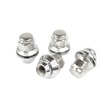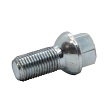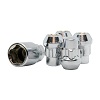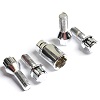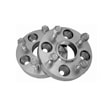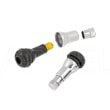New tires and rims in Formula 1 - what has changed?
New tires in Formula 1 are pretty much an annual standard, and this year they have undergone significant changes as well.
Find out how the new solutions differ. The rims in Formula 1 were also changed last year, so the combined impact of the new tires and rims on racing is quite significant and is evident during this season.
Why are tires and rims important in Formula 1?
Rims and tires are extremely important in Formula 1, as in any race, although the higher the speed, the more important they become. The same is true for cars that are used every day, although the extreme possibilities that F1 races have in common are rarely used in traffic. The tire ensures the vehicle's grip on the road, which is crucial both for acceleration and efficient cornering or braking. Of course, the whole efficiency is determined not only by the tyre, but also by the rim and suspension set in F1 before each race.
Changes to Formula 1 tires - what has changed specifically?
Formula 1 tires are constantly evolving. From the 2022 season, the size of the rims has been changed to a larger one, which means a change in the height of its profile (sidewall height) while maintaining the tire size. In 2023, the composition of the compound from which tires are made has changed - both those for dry and wet track and the so-called intermediate tyres.
1. Tire width
The tires in Formula 1 have retained their width - it is exactly 305 millimeters on the front axle and 405 millimeters on the rear axle. However, their height has increased - before 2022 it was 670 millimeters, now it is 720 millimeters.
2. Design and related changes
As already mentioned, because the diameter of the rim has increased from 13 to 18 inches, this means a significant reduction in the height of the sidewalls. As expected, this design of Formula 1 tires affected the handling of the cars. Lower sidewalls mean more cornering stability and less impact on the car's aerodynamics. This means less differences between the vehicles of different F1 teams that build their own cars, but the tires are supplied by Pirelli identically.
3. New rubber compounds
In 2023, Pirelli changed the compounds from which tires in Formula 1 are made. The new 'rubbers' are much harder to withstand the ever-increasing stresses associated with stronger and better turning cars. The changes covered both compounds in slick tires for dry surfaces as well as rain and intermediate tyres.

New rims in Formula 1 - what are the most important changes?
Changes to Formula 1 rims are much less frequent than those to tires or other components that change constantly. Nevertheless, in 2022, the rims in Formula 1 also changed the specification.
1. Bigger rims
From the 1960s, F1 tire rims were 13 inches in diameter. This has now been changed to 18 inches. The main reason cited was to make more space for the huge brake discs and to better vent them.
2. The use of composite technologies
Although tires made of composite materials have been tested at various times, Formula 1 wheels are now made of aluminium-magnesium alloy and supplied by one manufacturer, BBS.
How do changes to tires and rims affect Formula 1 racing?
Each change of tires and rims affects the properties of the cars to a greater or lesser extent, and thus also the course of the races, their speed or the possibility of direct competition of drivers.
1. Improved traction and grip
Larger wheels cause much better grip, which is important when accelerating, braking or braking, as well as when cornering fast.
2. Increasing speed and performance
A bigger rim means more weight, which should slow the cars down a bit. Changes in tire deflection - smaller profile means less deflection - have a positive effect on aerodynamics. The cars are getting faster anyway because of the other modifications and that's why the rims and tires have been changed to be able to withstand the new stresses. In total, the speed and performance of the cars increased.
3. Safety and risk minimization
Better mixtures, among other things, are characterized by greater strength. This means increased safety, as tire failure at 300 km/h can be very serious, and now it will be less likely.
The changes to the aerodynamics as a result of the larger wheels should make it a bit easier for the head-to-head fight between the drivers. When driving behind someone, so far the aerodynamic downforce has dropped so much that overtaking someone in these conditions was very difficult. It is now supposed to be easier, which should make the spectacle that is every Formula 1 race more attractive.
What are the challenges of new tires and rims in Formula 1?
Each change requires drivers and teams to adapt to the new rules and conditions.
1. Testing and optimization of the structure
Testing is one of the most important things. Suspension settings, aero components and much more are adjusted for each track, predicted weather, individual driver and many other variables. Changes in the wheels forced the use of a slightly softer suspension.
2. Adjusting racing strategies
The durability of the tires often changes the strategy of the whole race, where the number of tire changes and the timing of the pit stop is often crucial. Strategies are developed before the race, but they are also often changed on the fly when, for example, a safety car appears on the track.
3. Preparation of technical teams and drivers
The change in tire compound also influenced the use of electric tire warmers. Previously, it even happened that the tires were heated to 100 degrees Celsius at the front and 80 at the rear. This was lowered to 70 degrees, then 50 and in 2024 it is planned to completely abandon the use of pre-launch tire warming with heating blankets. For the team and the drivers, this means adapting to the fact that the start of the race will take place in completely different conditions.
What future changes to Formula 1 tires or changes to Formula 1 rims will look like is difficult to predict. For now, it will likely be a continuous evolution towards more durable and lighter materials. Perhaps the technology of rims in F1 will someday change to the use of light and durable carbon composites, and the tires will stop being inflated and will be made of some kind of foam, which has been talked about and predicted in the civil industry for years, although there are still no commercial ones on sale solutions of this type. Everyday motoring is dominated by aluminum rims and tires with tread, which you can inflate with nitrogen, as in F1 and other racing series.
It is worth mentioning here that not all changes are caused by the desire to increase the performance of F1 cars. The impact of ecological activities is large. After every F1 race, there are around 1,800 more or less used tires. A tire is considered worn in F1 if it has been stretched onto the rim. Reducing the number of tires used is certainly an ecological measure, although it has an impact on the course of the races. The new tire regulations in F1 will probably go towards ecology, regardless of what racing fans think about it.
The influence of business and marketing on Formula racing is also large. Currently, there is a monopoly in both tires (Pirelli) and rims (BBS). This was not always the case and in other racing series, for example, Yokohama tires or many other manufacturers are often used.




 Nowoczesny design
Nowoczesny design Idealne dopasowanie
Idealne dopasowanie Duża wytrzymałość
Duża wytrzymałość Wysyłka gratis w 24h
Wysyłka gratis w 24h
 Indywidualny projekt
Indywidualny projekt Dedykowany opiekun
Dedykowany opiekun
